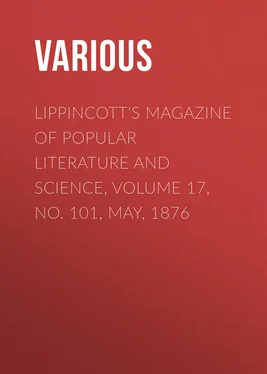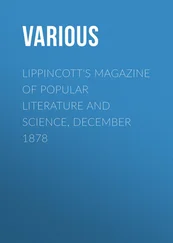Various - Lippincott's Magazine of Popular Literature and Science, Volume 17, No. 101, May, 1876
Здесь есть возможность читать онлайн «Various - Lippincott's Magazine of Popular Literature and Science, Volume 17, No. 101, May, 1876» — ознакомительный отрывок электронной книги совершенно бесплатно, а после прочтения отрывка купить полную версию. В некоторых случаях можно слушать аудио, скачать через торрент в формате fb2 и присутствует краткое содержание. Издательство: Иностранный паблик, Жанр: foreign_antique, periodic, foreign_edu, на английском языке. Описание произведения, (предисловие) а так же отзывы посетителей доступны на портале библиотеки ЛибКат.
- Название:Lippincott's Magazine of Popular Literature and Science, Volume 17, No. 101, May, 1876
- Автор:
- Издательство:Иностранный паблик
- Жанр:
- Год:неизвестен
- ISBN:нет данных
- Рейтинг книги:3 / 5. Голосов: 1
-
Избранное:Добавить в избранное
- Отзывы:
-
Ваша оценка:
- 60
- 1
- 2
- 3
- 4
- 5
Lippincott's Magazine of Popular Literature and Science, Volume 17, No. 101, May, 1876: краткое содержание, описание и аннотация
Предлагаем к чтению аннотацию, описание, краткое содержание или предисловие (зависит от того, что написал сам автор книги «Lippincott's Magazine of Popular Literature and Science, Volume 17, No. 101, May, 1876»). Если вы не нашли необходимую информацию о книге — напишите в комментариях, мы постараемся отыскать её.
Lippincott's Magazine of Popular Literature and Science, Volume 17, No. 101, May, 1876 — читать онлайн ознакомительный отрывок
Ниже представлен текст книги, разбитый по страницам. Система сохранения места последней прочитанной страницы, позволяет с удобством читать онлайн бесплатно книгу «Lippincott's Magazine of Popular Literature and Science, Volume 17, No. 101, May, 1876», без необходимости каждый раз заново искать на чём Вы остановились. Поставьте закладку, и сможете в любой момент перейти на страницу, на которой закончили чтение.
Интервал:
Закладка:
Another religious body ranges itself in the cause of art by the side of one with which it does not habitually co-operate. Dr. Witherspoon, the only clerical Signer, is its contribution in bronze. The Geneva gown supplies the grand lines lacking in the secular costume of the period, and indues the patriot with the silken cocoon of the Calvinist. The good old divine had well-cut features, which take kindly to the chisel. The pedestal is of granite.
Of other statues we shall take another occasion to speak. The tinkle of fountains leads us on to Horticultural Hall, where they give life and charm to the flowers. Painted thus in water-colors, the blossoms and leaves of the tropics glow with a freshness quite wonderful in view of the very short time the plants have been in place and the exposure they unavoidably encountered in reaching it. From the interior and exterior galleries of this exquisite structure one can look down, on one side, upon the palms of the Equator and on the other upon the beech and the fir, which interlock their topmost sprays at his feet. Beyond and beneath the silvery beeches railway-trains whisk back and forth, like hares athwart the covert—the tireless locomotive another foil to the strangers from the land of languor and repose.
The manufacture of a torrid climate on so large a scale will strike the visitor as one of the most curious triumphs of ingenuity in the whole exposition. Moisture is an essential only second in importance to heat. The two must be associated to create the normal atmosphere of most of the vegetation of the central zone. Art, in securing that end, reverses the process of Nature. The heat here is supplied from below and moisture from above, thus transposing the sun and the swamp. In summer, indeed, the sun of our locality, reinforced by glass, will as a rule furnish an ample supply of warmth. Very frequently it will be in excess, and allow the imprisoned strangers the luxury of all the fresh air they can crave. Our summer climate is in this way more favorable than that of Kew, which in turn has the advantage in winter. The inferior amount of light throughout the year and the long nights of winter in a high latitude again operate against the English horticulturists, and leave, altogether, a balance in our favor which ought to make the leading American conservatory the most successful in the world.
Standing by the marble fountain in the great hall, with its attendant vases and statuary, the visitor will not suspect that the pavement beneath his feet is underlaid by four miles of iron pipe four inches in diameter and weighing nearly three hundred tons. Through this immense arterial and venous system circulates the life-blood of the plants, hot water being the vehicle of warmth in winter. These invisible streams will flow when the brooks at the foot of the hill are sealed by frost and the plash of the open-air fountains is heard no longer.
Another current, more conspicuous and abounding—that of hurrying human feet—will make this magnificent conservatory the centre of one of its principal eddies. A second will be the Japanese head-quarters, and a third Memorial Hall. The outlandish and the beautiful in Nature and in art take chief hold of our interest. It wanders elsewhere, but reverts to what typifies the novel and the charming. From the Mongols and the palms it will drift to the granite portals that are flanked by the winged Viennese horses and the colossal figures of Minerva in the act of bridling them. Pegasus is not very worthily represented by these bronzes. The horses, however, are the better part of the two groups; the goddesses being too tall in proportion and heavy and ungraceful in build. The finer things which they sentinel, in bronze, marble or canvas, do not belong to the scope of this article. Yet we cannot postpone to the occasion of their notice in detail a tribute to him to whose energy and judgment we owe the filling of the Art Building with works fit to be there. For the accomplishment of this task the principal credit is due to John Sartain of Philadelphia, the Nestor of American engravers. But for Mr. Sartain's efforts, the studios of the best artists of America, especially, would have been much less adequately represented, while the walls would have been in danger of defacement by a flood of inferior productions. To secure the best, and the best only, of what artists and collectors could give, committees were appointed to inspect the offerings of the principal cities and select works of real merit. The difficulties in the way are appreciable only by those familiar with the diversities of feeling and opinion which are apt to make shipwreck of art-exhibitions. They have been overcome, and American artists have united in the practical measures needed to ensure them as fair a position by the side of foreign competitors as their actual merits can sustain.
It could hardly have been a recognition of carriage-making as one of the fine arts that caused the placing of an immense receptacle for such vehicles in so prominent a position near Memorial Hall. This structure stands opposite the western half of the Main Building. Combined with the annex erected for a like purpose by the Bureau of Agriculture, which covers three acres, it would seem to afford room for specimens of every construction ever placed on wheels since Pharaoh's war-chariots limbered up for the Red Sea campaign. These collections have no trifling significance as a sign of progress. They are the product of good roads, one of the surest traces of civilization. A century ago, a really good road was almost an unknown thing. So recently as half so long since one of the light equipages now so familiar to us would have been a simple impossibility. What words of ecstasy Dr. Johnson, who pronounced the height of bliss to be a drive over a turnpike of his day in a cranky post-chaise, would have applied to a "spin" in one of these wagons, no imagination can guess.
Let us not boast ourselves over the sages who had the misfortune of living too soon. It would be falling into the same blunder Macaulay ascribed to Johnson in alleging that the philosopher thought the Athenian populace the inferiors of Black Frank his valet, because they could not read and Frank could. Our heads are apt to be turned by our success in throwing together iron, timber, stone and other dead matter. Let us remember that we are still at school, with no near prospect of graduating. Many of our contemporary nations, to say nothing of those who are to come after us, claim the ability to teach us, as their being here proves. The assumption speaks from the stiff British chimneys, the pert gables of the Swedes and the laboriously wrought porticoes of the Japanese. This is well. It would be a bad thing for its own future and for that of general progress could any one people pronounce itself satisfied with what it had accomplished and ready to set the seal to its labors.
GLIMPSES OF CONSTANTINOPLE
TWO PAPERS.—I
We sailed from Trieste in the Venus, one of the Austrian Lloyds, with a very agreeable captain, who had been all over the world and spoke English perfectly. There were very few passengers—only one lady besides myself, and she was a bride on her way to her new home in Constantinople. She was a very pretty young Austrian, only seventeen, but such an old "Turk of a husband" as she had! Her mother was a Viennese, and her father a wealthy Englishman: what could have induced them to marry their pretty young daughter to such a man? He was a Greek by descent, but had always lived in Constantinople. Short, stout, cross-eyed, with a most sinister expression of countenance, old enough to be her father, the contrast was most striking. His wife seemed very happy, however, and remarked in a complacent tone that her husband was quite European. So he was, except that he wore a red fez cap, which was, to say the least, not "becoming" to his "style of beauty."
Читать дальшеИнтервал:
Закладка:
Похожие книги на «Lippincott's Magazine of Popular Literature and Science, Volume 17, No. 101, May, 1876»
Представляем Вашему вниманию похожие книги на «Lippincott's Magazine of Popular Literature and Science, Volume 17, No. 101, May, 1876» списком для выбора. Мы отобрали схожую по названию и смыслу литературу в надежде предоставить читателям больше вариантов отыскать новые, интересные, ещё непрочитанные произведения.
Обсуждение, отзывы о книге «Lippincott's Magazine of Popular Literature and Science, Volume 17, No. 101, May, 1876» и просто собственные мнения читателей. Оставьте ваши комментарии, напишите, что Вы думаете о произведении, его смысле или главных героях. Укажите что конкретно понравилось, а что нет, и почему Вы так считаете.












